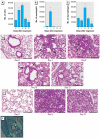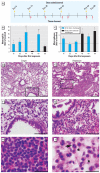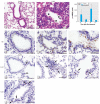Lung inflammation, injury, and proliferative response after repetitive particulate hexavalent chromium exposure
- PMID: 20049209
- PMCID: PMC2799464
- DOI: 10.1289/ehp.0900715
Lung inflammation, injury, and proliferative response after repetitive particulate hexavalent chromium exposure
Abstract
Background: Chronic inflammation is implicated in the development of several human cancers, including lung cancer. Certain particulate hexavalent chromium [Cr(VI)] compounds are well-documented human respiratory carcinogens that release genotoxic soluble chromate and are associated with fibrosis, fibrosarcomas, adenocarcinomas, and squamous cell carcinomas of the lung. Despite this, little is known about the pathologic injury and immune responses after repetitive exposure to particulate chromates.
Objectives: In this study we investigated the lung injury, inflammation, proliferation, and survival signaling responses after repetitive exposure to particulate chromate.
Methods: BALB/c mice were repetitively treated with particulate basic zinc chromate or saline using an intranasal exposure regimen. We assessed lungs for Cr(VI)-induced changes by bronchoalveolar lavage, histologic examination, and immunohistochemistry.
Results: Single exposure to Cr(VI) resulted in inflammation of lung tissue that persists for up to 21 days. Repetitive Cr(VI) exposure induced a neutrophilic inflammatory airway response 24 hr after each treatment. Neutrophils were subsequently replaced by increasing numbers of macrophages by 5 days after treatment. Repetitive Cr(VI) exposure induced chronic peribronchial inflammation with alveolar and interstitial pneumonitis dominated by lymphocytes and macrophages. Moreover, chronic toxic mucosal injury was observed and accompanied by increased airway pro-matrix metalloprotease-9. Injury and inflammation correlated with airways becoming immunoreactive for phosphorylation of the survival signaling protein Akt and the proliferation marker Ki-67. We observed a reactive proliferative response in epithelial cells lining airways of chromate-exposed animals.
Conclusions: These data illustrate that repetitive exposure to particulate chromate induces chronic injury and an inflammatory microenvironment that may promote Cr(VI) carcinogenesis.
Keywords: chromium; hexavalent; inflammation; injury; intranasal; lung; proliferation; repair.
Figures




References
-
- Albini A, Sporn MB. The tumour microenvironment as a target for chemoprevention. Nat Rev Cancer. 2007;7:139–147. - PubMed
-
- Altomare DA, Testa JR. Perturbations of the AKT signaling pathway in human cancer. Oncogene. 2005;24:7455–7464. - PubMed
-
- American Cancer Society. Cancer Facts & Figures 2008. Atlanta, GA: American Cancer Society; 2008. [[accessed 29 October 2009]]. Available: http://www.cancer.org/docroot/stt/content/stt_1x_cancer_facts_and_figure....
-
- Antonini JM, Stone S, Roberts JR, Chen B, Schwegler-Berry D, Afshari AA, et al. Effect of short-term stainless steel welding fume inhalation exposure on lung inflammation, injury, and defense responses in rats. Toxicol Appl Pharmacol. 2007;223:234–245. - PubMed
-
- ATSDR. Toxicological Profile for Chromium. Atlanta, GA: Agency for Toxic Substances and Disease Registry; 2000. - PubMed
Publication types
MeSH terms
Substances
Grants and funding
LinkOut - more resources
Full Text Sources
Medical
Molecular Biology Databases

